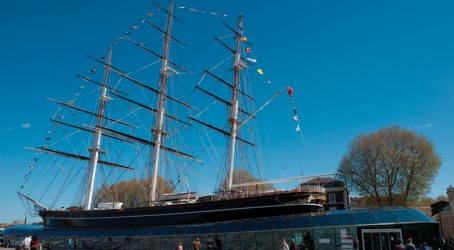Museums
Envisage an elegant ship sailing across the stormy seas, its sails soaring high in the wind. The vessel “clips” through storms while its precious, fragrant cargo is stored safely within.
The chances are that you’ve just pictured a ship that bears a remarkable resemblance to one of the most famous tea clippers in the world – the Cutty Sark.
The clipper began her eventful journey almost 150 years ago, when she was built with the sole purpose of transporting tea from China to London.
Today the clipper’s seafaring days are over. But, following five years of painstaking restoration work at the dry dock in Greenwich where it has been berthed since 1954, the ship has metamorphosed into a stunning visitor attraction.
The visitors’ entrance is through a gaping hole in the lower hold, where dozens of replica tea chests and videos explaining the tea trade are to be found, accompanied by musty smells and exotic sounds.
Victorians were willing to pay a premium for the first tea of the season, fuelling rivalry among the ships to make the quickest passage.
Although Cutty Sark was not the fastest, taking on average just over 100 days to reach China, it was sturdy and reliable.
Commissioned by a Scotsman, the clipper is of composite construction – built from wood and metal. The wrought-iron framework, resembling a ribcage, was decked out with teak and rock elm planks.
Helpfully, the original metalwork has been painted white, while the new metalwork is grey. It’s easy to see why this hearty clipper was one of the last remaining ships to sail in the tea trade, and the last of its kind to remain afloat.
Images and snippets of information are projected onto the inside of the hull – a great example of old technology blending with new.
A wander up the stairs leads to the tween deck, where displays show other types of cargo carried aboard, including wool, whisky, coal, gunpowder and even liquorice. There’s also a wealth of information about the crew members.
Dozens of digital interactive exhibits are littered over the deck.Find out what it was like to be a seaman by having a go at scrubbing the deck, discover about different ports and cargoes, or check if your name is on any of the crew lists.
Aspiring captains can have a go at steering from Sydney to London without running the clipper aground – it’s trickier than it first appears.
The last flight of stairs leads to the main deck where the ship can be seen in its full glory, exactly as it would have been in 1872. The masts tower above and the view across the Thames is spectacular.
However, the ship’s real treasure lies deep beneath. From the dry dock, the entire lower form of Cutty Sark can be seen. The clipper is raised above head height so that visitors can walk underneath and admire the copper-alloy sheathing on the hull.
This landmark piece of maritime engineering will leave you in awe.
